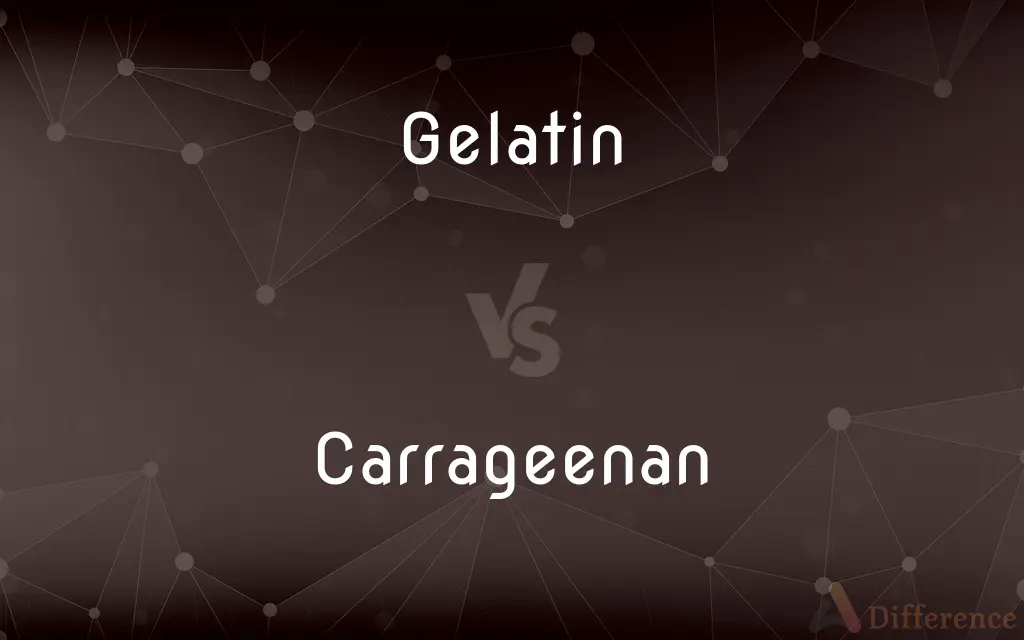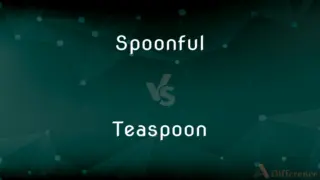Gelatin vs. Carrageenan — What's the Difference?
By Maham Liaqat & Urooj Arif — Updated on March 29, 2024
Gelatin is a protein derived from animal collagen, used as a gelling agent in foods, while carrageenan is a carbohydrate extracted from red seaweed, used as a thickener and stabilizer.

Difference Between Gelatin and Carrageenan
Table of Contents
ADVERTISEMENT
Key Differences
Gelatin, obtained by boiling animal bones, skins, and connective tissues, is a versatile ingredient renowned for its ability to form firm, transparent gels at low concentrations. It is widely used in the production of desserts, jellies, candies, and as a stabilizer in dairy products. On the other hand, carrageenan is sourced from specific types of red seaweed and is valued in the food industry for its ability to thicken, gel, and stabilize a wide array of products, including vegan and vegetarian alternatives, dairy products, and processed foods, without the need for refrigeration to set.
While gelatin dissolves in hot water and forms gels upon cooling, carrageenan can gel at room temperature and offers a range of textures from soft to firm gels, depending on the type used (iota, kappa, or lambda). Gelatin's animal-based origin raises dietary and ethical concerns for vegetarians, vegans, and certain religious groups, whereas carrageenan serves as a popular plant-based alternative that accommodates these dietary restrictions.
The processing of gelatin typically involves prolonged boiling of animal parts, which can carry flavors and odors, necessitating purification steps to ensure it is odorless and tasteless. Carrageenan extraction, however, involves boiling the seaweed in a gentle alkaline solution, often resulting in a neutral taste that makes it easy to incorporate into various food products without altering their flavor profiles.
Nutritionally, gelatin is rich in protein and can offer health benefits such as supporting joint, bone, and skin health due to its unique amino acid composition. Carrageenan, being a polysaccharide, does not provide protein but is used for its functional properties in foods rather than nutritional benefits. Both gelatin and carrageenan have been the subject of health debates, with some concerns raised about carrageenan's gastrointestinal tolerance in sensitive individuals.
Despite their differences, both gelatin and carrageenan play crucial roles in the food industry, offering unique properties that enhance the texture, stability, and appearance of a wide range of products, making them indispensable in formulating both traditional and innovative food items.
ADVERTISEMENT
Comparison Chart
Source
Animal collagen (bones, skins)
Red seaweed
Type
Protein
Carbohydrate (polysaccharide)
Dietary Suitability
Not suitable for vegans/vegetarians
Suitable for vegans/vegetarians
Use
Gelling agent in desserts, stabilizer
Thickener, stabilizer in foods
Gel Formation
Requires cooling
Can gel at room temperature
Flavor Impact
Neutral after purification
Naturally neutral
Health Benefits
Supports joint, bone, skin health
Used for functional properties
Compare with Definitions
Gelatin
Derived from animal collagen.
The gelatin in this dessert comes from boiling cow bones.
Carrageenan
No nutritional value.
While carrageenan enhances food texture, it does not contribute nutritional protein like gelatin.
Gelatin
Protein-based gelling agent.
Gelatin is used to create the gummy texture in candies and marshmallows.
Carrageenan
Plant-based alternative.
Vegetarian jelly is made possible with carrageenan instead of gelatin.
Gelatin
Used in photography.
Gelatin is also used in photographic films and papers for coating.
Carrageenan
Used in toothpaste.
Carrageenan acts as a stabilizer in toothpaste, preventing ingredient separation.
Gelatin
Forms firm gels.
Gelatin is essential for the firm set of this panna cotta.
Carrageenan
Seaweed-based thickener.
Carrageenan is used to improve the texture of non-dairy milk.
Gelatin
Health supplement.
Gelatin supplements are popular for promoting joint and skin health.
Carrageenan
Variety of textures.
Different types of carrageenan are used to achieve varying degrees of firmness in vegan cheeses.
Gelatin
Gelatin or gelatine (from Latin: gelatus meaning "stiff" or "frozen") is a translucent, colorless, flavorless food ingredient, commonly derived from collagen taken from animal body parts. It is brittle when dry and gummy when moist.
Carrageenan
Carrageenans or carrageenins ( karr-ə-gee-nənz, from Irish carraigín, "little rock") are a family of natural linear sulfated polysaccharides that are extracted from red edible seaweeds. The most well-known and still most important red seaweed used for manufacturing the hydrophilic colloids to produce carrageenan is Chondrus crispus (Irish moss) which is a dark red parsley-like plant that grows attached to the rocks.
Gelatin
A colorless or slightly yellow, transparent, brittle protein formed by boiling the specially prepared skin, bones, and connective tissue of animals and used in foods, drugs, and photographic film.
Carrageenan
Any of a group of closely related colloids derived from Irish moss and several other red algae, widely used as a thickening, stabilizing, emulsifying, or suspending agent in industrial, pharmaceutical, and food products.
Gelatin
Any of various similar substances.
Carrageenan
A food additive made from a purified extract of red seaweed, commonly used as a thickening agent.
Gelatin
A jelly made with gelatin, used as a dessert or salad base.
Carrageenan
A colloidal material obtained from seaweed or Irish moss, used as an thickening or emulsifying agent and for stabilizing foods, cosmetics, and pharmaceuticals.
Gelatin
A thin sheet made of colored gelatin used in theatrical lighting. Also called gel.
Carrageenan
A colloidal extract from carrageen seaweed and other red algae
Gelatin
A protein derived through partial hydrolysis of the collagen extracted from animal skin, bones, cartilage, ligaments, etc.
Gelatin
An edible jelly made from this material.
Gelatin
A thin, translucent membrane used as a filter for photography or for theatrical lighting effects.
Gelatin
Animal jelly; glutinous material obtained from animal tissues by prolonged boiling. Specifically (Physiol. Chem.), a nitrogeneous colloid, not existing as such in the animal body, but formed by the hydrating action of boiling water on the collagen of various kinds of connective tissue (as tendons, bones, ligaments, etc.). Its distinguishing character is that of dissolving in hot water, and forming a jelly on cooling. It is an important ingredient of calf's-foot jelly, isinglass, glue, etc. It is used as food, but its nutritious qualities are of a low order.
Gelatin
A colorless water-soluble glutinous protein obtained from animal tissues such as bone and skin
Gelatin
An edible jelly (sweet or pungent) made with gelatin and used as a dessert or salad base or a coating for foods
Gelatin
A thin translucent membrane used over stage lights for color effects
Common Curiosities
Can gelatin and carrageenan be used interchangeably?
They cannot always be directly substituted due to differences in gelation properties and dietary restrictions, but can achieve similar purposes with recipe adjustments.
Are there any health concerns associated with carrageenan?
Some studies have raised concerns about gastrointestinal effects, but food-grade carrageenan is considered safe for most people.
Can I find vegan gelatin?
Vegan "gelatin" substitutes, such as agar-agar or pectin, are derived from plants and can mimic gelatin's properties.
Can people with seafood allergies use carrageenan?
Carrageenan is generally considered safe for individuals with seafood allergies, as it's derived from seaweed and not seafood.
Is carrageenan a healthier alternative to gelatin?
Carrageenan offers a plant-based alternative with different health considerations; it's not inherently healthier but suits different dietary needs.
What are the environmental impacts of gelatin and carrageenan production?
Gelatin production is tied to the meat industry, with its associated environmental impacts, while carrageenan production depends on sustainable seaweed farming practices.
Why is gelatin not suitable for vegetarians?
Gelatin is derived from animal parts, making it unsuitable for vegetarian and vegan diets.
Is all carrageenan the same?
No, carrageenan is available in several forms (iota, kappa, lambda), each with different properties and uses in food production.
How do I choose between gelatin and carrageenan for my recipe?
Consider dietary restrictions, desired texture, and whether the recipe needs to set without refrigeration when choosing between these two.
How does gelatin contribute to food texture?
Gelatin can create a range of textures from soft gels to firm, rubbery consistencies depending on its concentration.
Share Your Discovery

Previous Comparison
Spoonful vs. Teaspoon
Next Comparison
Shroud vs. VeilAuthor Spotlight
Written by
Maham LiaqatCo-written by
Urooj ArifUrooj is a skilled content writer at Ask Difference, known for her exceptional ability to simplify complex topics into engaging and informative content. With a passion for research and a flair for clear, concise writing, she consistently delivers articles that resonate with our diverse audience.














































